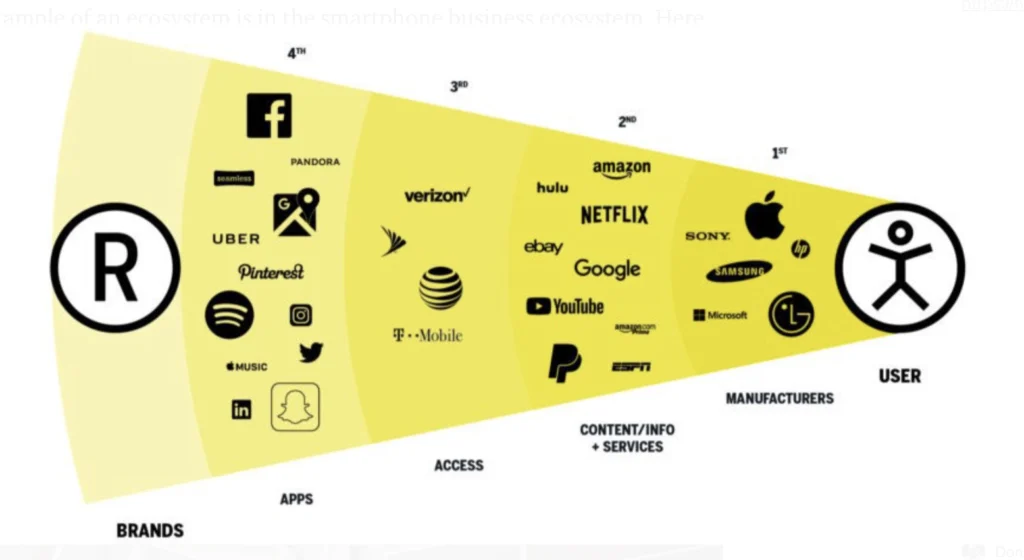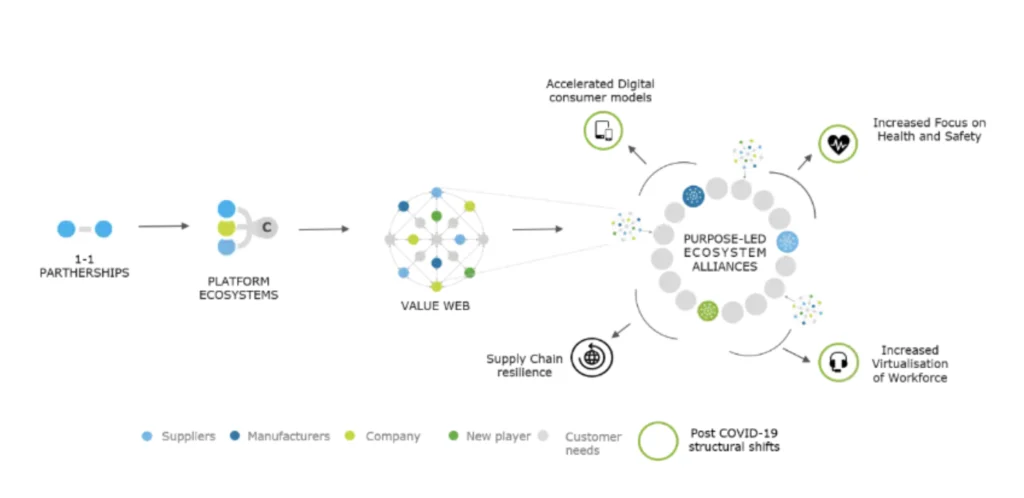How to Build a Purpose-Driven Brand Ecosystem
A purpose-driven brand has goals beyond just increasing its revenue. It looks at how it can improve society, the environment, and the world for future generations. When you work alongside partners, you can have a greater impact and reach more of your goals through a purpose-driven ecosystem.
Learn seven steps to build your purpose-driven brand ecosystem.
Key Takeaways:
- A business ecosystem is a partnership of companies and individuals working towards the same goal.
- Make your ecosystem purpose-driven by measuring your results by your environmental and social impact rather than by revenue growth.
- Your ecosystem is an ever-changing partnership that shifts as customer behavior, societal needs, and technological advances change.
What Is a Business’s Ecosystem?
The most common definition of an ecosystem is a group of organisms in a physical environment. For example, a pond’s ecosystem consists of frogs, fish, bugs, birds, and plants. All these organisms contribute to that environment’s well-being.
A business’s ecosystem works similarly. It’s a collection of contributors who work together towards a common goal or to serve the same customers. In 2022, ecosystems often include several digital partnerships or companies that share their digital audience and reach. This can be other brands or individual influencers who work alongside your brand to promote your products.
Businesses collaborating in a digital partnership benefit from greater customer reach and range. This results in greater revenue as much as 10 percentage points above average.
How Is That Different from Your Business’s Supply Chain?
Your business ecosystem is very similar to your supply chain, with one primary difference. A supply chain works in a long line, with products moving from one location to the next. As a result, the customer might only know about the contributors at the end of the chain and rarely know earlier contributors.
An ecosystem is an equal partnership where everyone contributes to the value of a product or service. The following image shows an example of a cell phone ecosystem. It consists of phone manufacturers, content, cell phone providers, and apps. Each section adds value to the others’ products or services.

Image from Medium
How Do You Make Your Ecosystem Purpose-Driven?
A purpose-driven ecosystem functions beyond just boosting each contributor’s sales. It’s also a partnership with a shared mission to serve a greater purpose and make a social impact. For example, it can be a collection of businesses, individuals, and startups working towards creating safer work environments or building more sustainable business models.

Image from Deloitte.
7 Steps to Build a Purpose-Driven Vendor Ecosystem
Use these steps to turn your company into a purpose-driven vendor ecosystem.
1. Designate a Leader
Every ecosystem starts with a leader who organizes and manages the ecosystem. About 58% of leaders build strategies that include ecosystems compared to 35% of followers.
When you choose to become the leader, you will review your purpose and goals, keep everyone aligned, and decide who joins the ecosystem. You will also manage and provide the necessary platforms to improve collaboration.
2. Identify a Foundational Need
Before building an ecosystem with a purpose-driven strategy, you must identify the need you want to fill. A purpose-led business isn’t profit-driven. Instead, it has a greater mission that improves the workplace, society, or the environment.
About 83% of consumers agree that a business’s revenue should reflect its impact on the world. This results in companies with a positive impact receiving more sales than those with little or no impact on social and environmental issues.
Some examples of purposes include:
- Creating safe work environments
- Using sustainable business practices
- Addressing world issues
- Fighting poverty
- Standing up for a social issue
The need you want to fill might directly relate to your business, like safer and healthier work environments. However, your purpose might also be a greater necessity outside of your business that affects society, like environmental and social issues.
Once you establish a need, you can create a purpose statement that addresses that need.
3. Select and Scale Partners
Your ecosystem isn’t a set system. Rather it’s a living partnership that will constantly shift as customer needs, your purpose, and technology change. Keeping it flexible allows you to continually fill gaps in your business and society with new systems to help you reach your goals.
For example, during COVID-19, many businesses dedicated to healthy and safe work environments transformed their businesses into remote workspaces. This led to partnerships with Zoom, Microsoft, and other companies that provide the necessary tools to build a remote workforce.
You can select and collaborate with businesses that can educate your partners on better practices, add value to your products, or improve your social and environmental impact.
4. Align Your Purpose
Once you choose your partners, you must align your purposes to ensure you’re all on the same page and working towards the same goals.
For example, if your partners want to increase their revenue while you want to decrease your environmental impact, you might run into conflicts of purpose. Acknowledging your shared objectives builds a foundation for a strong partnership where you work together instead of against each other.
Other areas to address are each collaborator’s investment, time commitment, and return. For instance, you can discuss whether you list each partner on every product or if you only acknowledge their contribution on your website and a few other select locations.
5. Establish Metrics of Success
Not only should you have the same purpose, but you and your partners need to establish the same benchmarks for measuring your success. This is especially necessary since many purpose-driven brands don’t have quantitative metrics but rather qualitative metrics. These are metrics that you can’t measure with specific numbers.
For instance, a safer work environment might not lead directly to a sale you can track. However, it does improve your business by reducing injuries and increasing worker satisfaction and productivity. Establishing which of these metrics you will use to measure how well you’re performing ensures everyone comes to the same results and agrees when you are achieving your purpose.
6. Support Each Other’s Cultures
A business ecosystem doesn’t mean that each organization must merge into the same business. One of the reasons ecosystems work well is because of the unique contributions from each partner. You must also support each company’s unique culture to ensure your ecosystem remains healthy.
For example, if one of your partners is a fully remote, international company, having in-person meetings or not considering different time zones when planning events goes against that company’s culture.
7. Manage Your Relationships
Managing your ecosystem is what keeps it healthy and growing. As the leader of your ecosystem, you must put the tools and systems in place to keep everyone connected.
Communication channels, combined data, regular meetings, and shared resources are essential functions of a healthy ecosystem. Everyone should stay informed about how well the ecosystem performs and whether you are achieving your purpose.
Invest in Your Purpose-Driven Brand
Televerde supports purpose-driven brand ecosystems by unifying your marketing, sales, and customer care departments. As a result, you can scale and build an omnichannel experience that connects your partners and delivers a purpose-driven message to your customers that will help you reach your goals.
Request a consultation and get started building your purpose-driven ecosystem.



